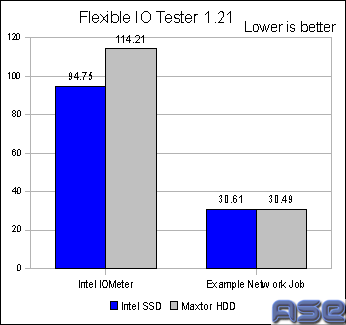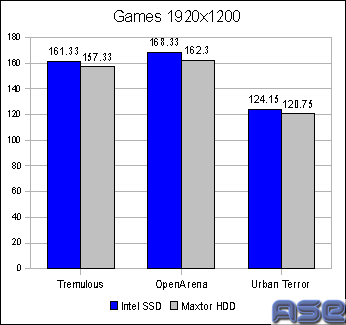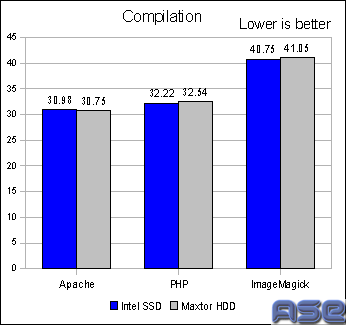Page All: Viewing All Pages
Page 1
Intro:
If there is one piece of technology that we at ASE Labs are hoping comes down enough in price, it has to be Solid State Disks (SSD). One of the last components in the general purpose computer that still contains mechanical parts is the Hard Disk Drive (HDD). A few people should remember years ago when solid state technology was on the verge of coming into mass storage technology, but it fizzled. Fast forward a few years and we have USB flash drives that operate on similar technology with good speed and ample storage. The next logical step is to take this technology to replace that last mechanical part. The X25-M fills that roll.
SSD:
Most new technology reviews on ASE Labs usually contain extra information about technology behind the product. With the SSD, we feel a better approach is to go more in-depth in a full featured article on how a SSD works in comparison to a normal HDD. Please check the site as we will be publishing the article very soon.
Intel's Approach:
Most readers might already be aware that there are a number of companies that currently produce (or re-brand) SSDs. Memory manufacturers are keen to get in on the new slice of market, it being a technology that they are somewhat familiar with. Brands such as OCZ, SuperTalent, Mtron, Patriot, and others have been shipping MLC and SLC type drives for some time. Intel took a different approach. While the majority of SSDs on the market today are similar drives just re-branded, Intel's SSD is built from the ground up. Intel knows chip technology and this SSD proves that. There are other products in the same family including an "Extreme" branded drive called the X25-E which is SLC. The acronyms will all be explained in a companion article to follow. This drive happens to be 2.5" as all SSDs for generalized computing are. The other size is 1.8" which Intel also offers. Hopefully cases will begin to accommodate this 2.5" size disk soon. In the meantime, builders will need to purchase converters.
Box:
It is a OEM product so this is a generic brown box. Yes, it is small since it is a laptop form factor. All SSDs are 2.5" and smaller as of now.
Unboxing it shows a simple sheet with the information on it.
The SSD itself is wrapped in an ESD bag. Unlike a normal HDD, this drive is very light in weight. It will be a boom for laptop when these drives take over from the older mechanical drives.
X25-M:
This is flash at its finest hour. Intel's first flash based mass storage drives will herald the transition away from mechanical mass storage technology. Once the price drops, this will be the technology for the future. The X25-M is considered a mainstream drive (the M in the model). Mainstream means two things; cheaper and slower. This drive uses NAND type storage with MLC technology to drive the price lower. MLC drives tend to be slower on writes than the more expensive SLC drives. This drive is rated for 70MB/s sustained writes and a huge 250MB/s of sustained reads. Those are megabytes, not bits. These drives are incredibly fast compared to the old mechanical drives.
Serial ATA connectivity is a given for an Intel SSD. It is SATA rev. 2 so it transfers at a maximum of 3Gb/s (Gigabits). This will be one of the first single drives that can almost saturate the Serial ATA bandwidth. On the same note, mechanical drives measured seek times (the time it takes to get to the data being requested) in milliseconds. The fastest enthusiast drive would probably be the WD VelociRaptor at 7.4ms. The Intel X25-M carries seek times of 85 microseconds. In terms of milliseconds, that is .085 milliseconds. I/O has always been a burden and random reads and writes have suffered. These SSDs clear the way for increased speed for all computing.
The X25-M is a standard 2.5" laptop size drive. It can easily fit in any standard laptop. Think about the cost savings of producing one drive form factor for all computers. In reality, it looks like 1.8" drives will be the new laptop drive standard in the coming years, so there will still be different size drives. Thankfully, the connectivity is the same due to Serial ATA. The test bench at ASE Labs has been running this Intel SSD for days and it is a dream to use.
Normally a new drive like this would be ripped apart to be displayed on the site. Unfortunately, this drive was purchased by a staff member to use in a personal notebook so it wouldn't be a good thing if it broke mid-review. The X25-M supports SMART monitoring which is good since the drive will know when cells are going bad and warn the user before hand. Even when a drive "dies" the data will not be lost, it just won't be overwritten. Failure is handled gracefully with a SSD.
The X25-M also supports NCQ which allows the host controller to send multiple commands to keep the drive busy and with a SSD, it keeps the host controller busy since seek times are less of an issue. Also less of an issue is the failure rate of the drive. We at ASE Labs can say that Intel usually has a good handle on the failure rate of their products and although we can't verify the claims, Intel says that the drive should last for at least five years. The five year estimate is with 100GB of writes daily. This is achieved thanks to the care Intel put in the block size and wear-leveling algorithm used in the SSD.
Intro:
If there is one piece of technology that we at ASE Labs are hoping comes down enough in price, it has to be Solid State Disks (SSD). One of the last components in the general purpose computer that still contains mechanical parts is the Hard Disk Drive (HDD). A few people should remember years ago when solid state technology was on the verge of coming into mass storage technology, but it fizzled. Fast forward a few years and we have USB flash drives that operate on similar technology with good speed and ample storage. The next logical step is to take this technology to replace that last mechanical part. The X25-M fills that roll.
SSD:
Most new technology reviews on ASE Labs usually contain extra information about technology behind the product. With the SSD, we feel a better approach is to go more in-depth in a full featured article on how a SSD works in comparison to a normal HDD. Please check the site as we will be publishing the article very soon.
Intel's Approach:
Most readers might already be aware that there are a number of companies that currently produce (or re-brand) SSDs. Memory manufacturers are keen to get in on the new slice of market, it being a technology that they are somewhat familiar with. Brands such as OCZ, SuperTalent, Mtron, Patriot, and others have been shipping MLC and SLC type drives for some time. Intel took a different approach. While the majority of SSDs on the market today are similar drives just re-branded, Intel's SSD is built from the ground up. Intel knows chip technology and this SSD proves that. There are other products in the same family including an "Extreme" branded drive called the X25-E which is SLC. The acronyms will all be explained in a companion article to follow. This drive happens to be 2.5" as all SSDs for generalized computing are. The other size is 1.8" which Intel also offers. Hopefully cases will begin to accommodate this 2.5" size disk soon. In the meantime, builders will need to purchase converters.
Box:
It is a OEM product so this is a generic brown box. Yes, it is small since it is a laptop form factor. All SSDs are 2.5" and smaller as of now.
Unboxing it shows a simple sheet with the information on it.
The SSD itself is wrapped in an ESD bag. Unlike a normal HDD, this drive is very light in weight. It will be a boom for laptop when these drives take over from the older mechanical drives.
X25-M:
This is flash at its finest hour. Intel's first flash based mass storage drives will herald the transition away from mechanical mass storage technology. Once the price drops, this will be the technology for the future. The X25-M is considered a mainstream drive (the M in the model). Mainstream means two things; cheaper and slower. This drive uses NAND type storage with MLC technology to drive the price lower. MLC drives tend to be slower on writes than the more expensive SLC drives. This drive is rated for 70MB/s sustained writes and a huge 250MB/s of sustained reads. Those are megabytes, not bits. These drives are incredibly fast compared to the old mechanical drives.
Serial ATA connectivity is a given for an Intel SSD. It is SATA rev. 2 so it transfers at a maximum of 3Gb/s (Gigabits). This will be one of the first single drives that can almost saturate the Serial ATA bandwidth. On the same note, mechanical drives measured seek times (the time it takes to get to the data being requested) in milliseconds. The fastest enthusiast drive would probably be the WD VelociRaptor at 7.4ms. The Intel X25-M carries seek times of 85 microseconds. In terms of milliseconds, that is .085 milliseconds. I/O has always been a burden and random reads and writes have suffered. These SSDs clear the way for increased speed for all computing.
The X25-M is a standard 2.5" laptop size drive. It can easily fit in any standard laptop. Think about the cost savings of producing one drive form factor for all computers. In reality, it looks like 1.8" drives will be the new laptop drive standard in the coming years, so there will still be different size drives. Thankfully, the connectivity is the same due to Serial ATA. The test bench at ASE Labs has been running this Intel SSD for days and it is a dream to use.
Normally a new drive like this would be ripped apart to be displayed on the site. Unfortunately, this drive was purchased by a staff member to use in a personal notebook so it wouldn't be a good thing if it broke mid-review. The X25-M supports SMART monitoring which is good since the drive will know when cells are going bad and warn the user before hand. Even when a drive "dies" the data will not be lost, it just won't be overwritten. Failure is handled gracefully with a SSD.
The X25-M also supports NCQ which allows the host controller to send multiple commands to keep the drive busy and with a SSD, it keeps the host controller busy since seek times are less of an issue. Also less of an issue is the failure rate of the drive. We at ASE Labs can say that Intel usually has a good handle on the failure rate of their products and although we can't verify the claims, Intel says that the drive should last for at least five years. The five year estimate is with 100GB of writes daily. This is achieved thanks to the care Intel put in the block size and wear-leveling algorithm used in the SSD.
Page 2
Testing:
The test system for this review consisted of the same system used in the previous »triple vs single channel memory article.
Intel DX58SO
Intel Core i7 920 (2.66GHz)
Kingston 3GB Triple Channel 1600MHz
Sapphire Radeon 4850
Maxtor 80GB SATA vs Intel 80GB SATA
Ubuntu 8.10
Phoronix Test Suite for testing
The comparison with a standard 80GB 7200 Serial ATA drive was done to show how much of a benefit a SSD can have over a normal HDD. There are some things that will not be faster including computational performance when the data is easily cached in the RAM. Benefits will be shown when data needs to be transfered to and from the mass storage device.
First up is a synthetic test called Bonie++. This test really shows the power of the SSD in terms of raw performance. Even though Bonie++ is a synthetic test, the results don't lie. This is an amazing product.
Lower is better in this instance and the SSD from Intel comes out on top in one of the tests. The network workload pretty much comes out even. The only time the SSD will wipe the floor with a standard drive is in high I/O situations.
In the gaming tests running at 1920x1200, the Intel X25-M pulls out a victory over the standard mechanical Maxtor drive. If the resolution was dropped the lead would probably be higher.
On the compilation tests, the X25-M is actually a tiny bit faster than the Maxtor drive. Compilation is rarely disk intensive unless it is something large (maybe the Linux kernel would be good).
Subjectively, the Intel X25-M feels faster overall. Bootup times for Ubuntu were faster by a few seconds and programs loaded much faster than with the Maxtor drive. Using the computer with the X25-M felt like a better overall experience and it is finally good to see the bottleneck in computers becoming less. Hard drives have long been a huge bottleneck and these new SSDs make it a a real treat to multi-task again. Doing anything intensive on the drive doesn't lock performance. You can do multiple operations on the drive with ease, unlike a mechanical drive which suffers. This is how computing should be.
Conclusion:
Here is the big problem with the X25-M, the price. The drive costs about $500-$600 at the time of this writing. For 80GB, this is extremely expensive. The cost is very prohibitive in anything but enterprise class hardware. Mainstream users should be looking for prices to drop on SSDs later in the year. We at ASE Labs are projecting a surge in SSDs this year which will push prices much lower. Perhaps in a few months the price will drop to a more manageable level.
As for Intel's technology, it is amazing. The X25-M shows what a good technology company can do when it is done right. Intel has hit a home run with this product and as soon as the price becomes more competitive, these drives will fly out of the factory. The team at ASE Labs really can't wait for it to happen and we look forward to not having mechanical mass storage in our systems. Thank you, Intel.
Testing:
The test system for this review consisted of the same system used in the previous »triple vs single channel memory article.
Intel DX58SO
Intel Core i7 920 (2.66GHz)
Kingston 3GB Triple Channel 1600MHz
Sapphire Radeon 4850
Maxtor 80GB SATA vs Intel 80GB SATA
Ubuntu 8.10
Phoronix Test Suite for testing
The comparison with a standard 80GB 7200 Serial ATA drive was done to show how much of a benefit a SSD can have over a normal HDD. There are some things that will not be faster including computational performance when the data is easily cached in the RAM. Benefits will be shown when data needs to be transfered to and from the mass storage device.
First up is a synthetic test called Bonie++. This test really shows the power of the SSD in terms of raw performance. Even though Bonie++ is a synthetic test, the results don't lie. This is an amazing product.
Lower is better in this instance and the SSD from Intel comes out on top in one of the tests. The network workload pretty much comes out even. The only time the SSD will wipe the floor with a standard drive is in high I/O situations.
In the gaming tests running at 1920x1200, the Intel X25-M pulls out a victory over the standard mechanical Maxtor drive. If the resolution was dropped the lead would probably be higher.
On the compilation tests, the X25-M is actually a tiny bit faster than the Maxtor drive. Compilation is rarely disk intensive unless it is something large (maybe the Linux kernel would be good).
Subjectively, the Intel X25-M feels faster overall. Bootup times for Ubuntu were faster by a few seconds and programs loaded much faster than with the Maxtor drive. Using the computer with the X25-M felt like a better overall experience and it is finally good to see the bottleneck in computers becoming less. Hard drives have long been a huge bottleneck and these new SSDs make it a a real treat to multi-task again. Doing anything intensive on the drive doesn't lock performance. You can do multiple operations on the drive with ease, unlike a mechanical drive which suffers. This is how computing should be.
Conclusion:
Here is the big problem with the X25-M, the price. The drive costs about $500-$600 at the time of this writing. For 80GB, this is extremely expensive. The cost is very prohibitive in anything but enterprise class hardware. Mainstream users should be looking for prices to drop on SSDs later in the year. We at ASE Labs are projecting a surge in SSDs this year which will push prices much lower. Perhaps in a few months the price will drop to a more manageable level.
As for Intel's technology, it is amazing. The X25-M shows what a good technology company can do when it is done right. Intel has hit a home run with this product and as soon as the price becomes more competitive, these drives will fly out of the factory. The team at ASE Labs really can't wait for it to happen and we look forward to not having mechanical mass storage in our systems. Thank you, Intel.











